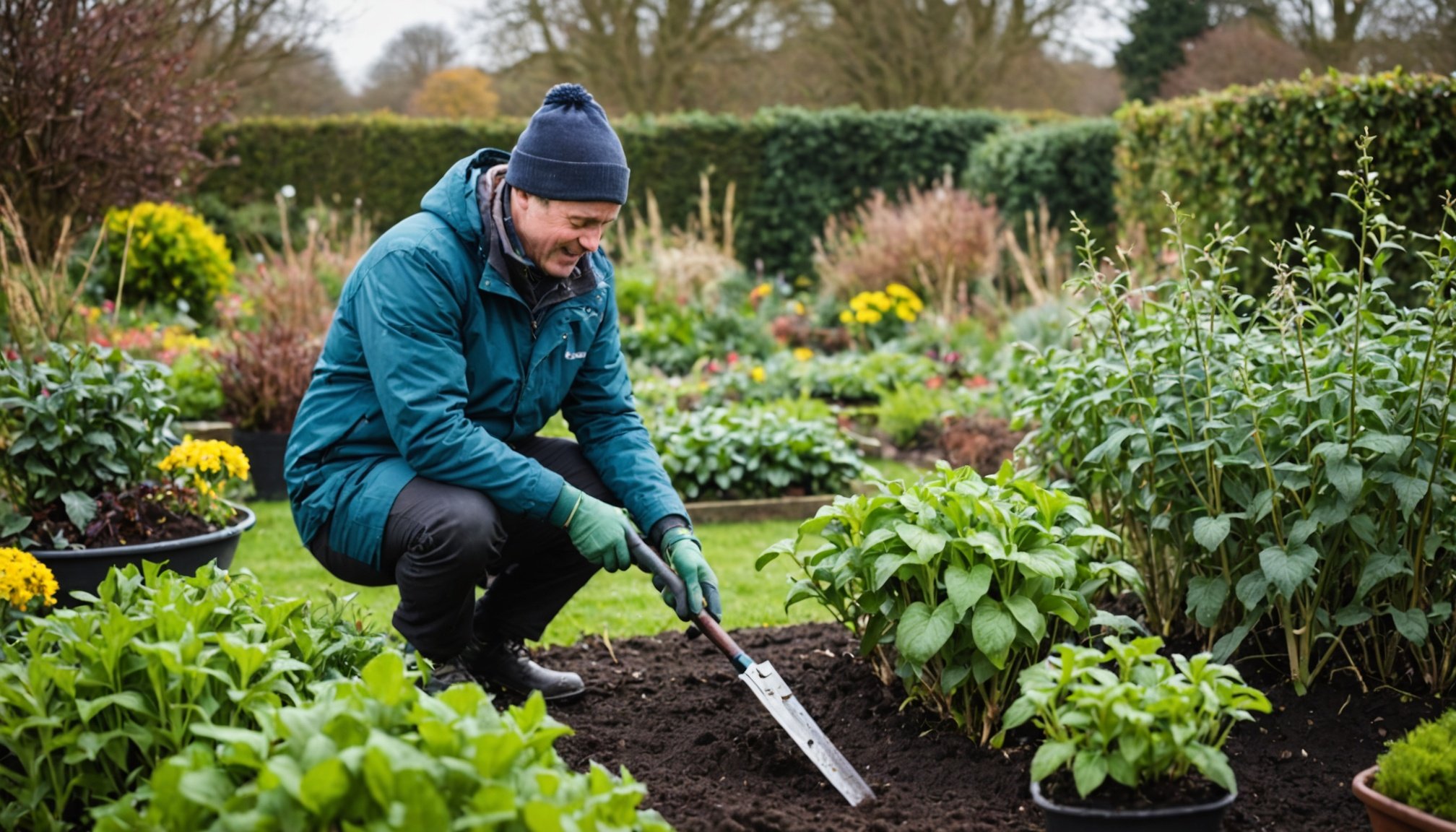Unlocking the Secrets to Thriving Winter Gardening in the UK’s Chilly Climate
As the winter months approach, many gardeners in the UK might think that their outdoor spaces are destined for a period of dormancy. However, with the right strategies and a bit of planning, you can keep your garden thriving even in the coldest of times. Here’s a comprehensive guide to help you unlock the secrets of successful winter gardening.
Preparing Your Garden for Winter
Before the first frost hits, it’s crucial to prepare your garden for the cold weather ahead. This involves several key tasks that will protect your plants, maintain soil health, and set your garden up for a strong start in the spring.
In parallel : Ultimate Guide: How to Successfully Overwinter Exotic Plants Indoors in the UK
Clear Out Dead Plants and Debris
Removing dead plants, weeds, and leftover debris is essential to prevent the spread of pests and diseases. This also helps in maintaining the aesthetic appeal of your garden. As noted by the experts at Green Living Blog, “Fallen leaves and dead plants, if left untouched, can contribute to soil-borne diseases and attract pests. Clear your garden of dead vegetation and excess leaves, and consider creating a compost pile or using eco-conscious clearance services”[3].
Prune Carefully for Spring Growth
Winter is the ideal time to prune trees, shrubs, and perennials. Pruning encourages new growth by removing diseased, damaged, or dead branches, creating a healthier and more attractive garden when spring arrives. However, be careful not to over-prune, especially for delicate species that may need extra protection from frost.
Also to see : Enhancing Vegetable Harvests: The Impact of Companion Planting in UK Allotments
### Pruning Tips:
- Prune deciduous trees and shrubs when they are dormant to minimize the risk of disease and pest issues.
- Remove any dead, diseased, or damaged branches to promote healthy growth.
- Use sharp, clean pruning tools to prevent spreading diseases.
- Consider hiring a professional if you are unsure about how to prune certain plants.
Planting and Maintaining During Winter
Despite the cold, winter is a great time for certain gardening activities that can give your garden a head start for the next growing season.
Hollow Tining Your Lawn
Hollow tining or coring your lawn is a beneficial practice that should be done before the spring. This process involves removing cores from the lawn to aerate and relieve compacted turf, allowing it to expand, receive more air, and absorb water more easily. According to horticultural scientist Janet Manning, “The oxygen in the air is important to keep the soil microorganisms alive, as they help the rain to infiltrate the soil”[1].
Planting Trees and Bare-Root Plants
Winter is an excellent time to plant trees and bare-root plants. Planting trees now allows their roots to establish themselves before the spring, reducing the need for frequent watering. Bare-root plants, typically hardy perennials, can also establish root growth during the winter, requiring less watering in the spring.
### Tips for Planting Trees and Bare-Root Plants:
- Plant trees in winter to allow their roots to establish before the spring.
- Soak bare-root plants in cold water for a couple of hours before planting.
- Ensure the soil is not waterlogged or frozen when planting.
- Add a generous layer of mulch around newly planted trees to reduce surface evaporation.
Sustainable Winter Garden Maintenance
Sustainable gardening practices are crucial for maintaining a healthy and environmentally friendly garden. Here are some tips to help you achieve this:
Clear Fallen Leaves and Dead Plants
Clearing fallen leaves and dead plants is not just about aesthetics; it also prevents soil-borne diseases and pest issues. Instead of sending these to the landfill, consider creating a compost pile. A balanced compost mix of “green” (nitrogen-rich) and “brown” (carbon-rich) materials can significantly enrich your soil.
Protect Soil with Mulch and Compost
Mulching and composting are key to preserving soil health during winter. Mulch insulates the soil, protecting plant roots from temperature fluctuations and preventing erosion. It also helps retain moisture, reducing the need for watering once spring arrives.
### Benefits of Mulching and Composting:
- Insulates the soil, protecting plant roots from frost.
- Prevents soil erosion and retains moisture.
- Supports natural soil health by adding organic matter.
- Reduces the need for excessive watering in the spring.
Creating a Wildlife-Friendly Garden
Winter is an excellent time to think about how your garden can support local wildlife. Here are some tips to make your garden more welcoming to birds, hedgehogs, and other creatures.
Plant for You and the Birds
Consider planting evergreen shrubs with long-lasting fruit, such as crab apples and Pyracantha. These plants provide aesthetic improvements and serve as a food source for visiting birds. Also, avoid removing too much ivy, as it provides crucial food for birds during the winter.
Provide Water and Shelter
Ensure that your garden provides water sources at different heights to cater to various wildlife, such as birds and hedgehogs. Keep this water clean and unfrozen. Additionally, create log piles and leave some areas of your garden untidy with leaf litter and twigs, providing shelter and warmth for small creatures.
### Wildlife Garden Tips:
- Plant evergreen shrubs with long-lasting fruit.
- Provide water sources at different heights.
- Create log piles for shelter and food.
- Leave some areas of the garden untidy to provide resting places.
Additional Winter Gardening Jobs
There are several other tasks you can undertake during the winter to keep your garden in top shape.
Organise Seeds
Go through your existing seeds and make a list of what you have and what you need to order for the next year. This is a great time to plan your garden for the upcoming growing season.
Force Bulbs
Continue to force prepared bulbs like hyacinths and daffodils by potting them indoors. This will allow you to stagger their flowering past Christmas and into January, adding some color and life to your winter garden.
Check Stored Produce
If you have stored fruits and vegetables, check them regularly for rodent damage or rot. Remove any affected produce to prevent contamination and ensure the rest remains healthy.
Tools and Equipment for Winter Gardening
Having the right tools and equipment can make a significant difference in your winter gardening endeavors.
Essential Tools
- Pruning Shears: For pruning trees, shrubs, and perennials.
- Garden Fork: For aerating the soil and removing debris.
- Mulch: To protect soil and retain moisture.
- Water Butt: To collect rainwater, which is softer and contains fewer chemicals than tap water.
Storing Tools Properly
Clean and store your gardening tools properly to ensure they remain in good condition. This includes cleaning off any dirt, drying the tools, and storing them in a dry place.
Winter gardening in the UK’s chilly climate is not just about survival; it’s about thriving. By following these tips, you can prepare your garden for the next growing season, support local wildlife, and maintain a healthy and sustainable outdoor space.
As Sarah Raven from Wildflower Magazine aptly puts it, “Mulching beds and borders insulates the soil, allows plant roots to retain warmth and moisture, and offers protection from frost damage. Apply a thick mulch to give your plants the best chance of surviving the winter”[4].
So, don’t let the cold weather deter you from enjoying your garden. With a little planning and the right techniques, you can unlock the secrets to thriving winter gardening and make the most of this often-underappreciated season.
Practical Insights and Actionable Advice
Here are some final tips to keep in mind as you embark on your winter gardening journey:
- Start Early: Begin preparing your garden for winter as soon as the growing season ends.
- Be Sustainable: Use eco-friendly practices like composting and mulching to maintain soil health.
- Support Wildlife: Create a wildlife-friendly garden by providing food, water, and shelter.
- Plan Ahead: Organize your seeds and plan your garden for the next growing season.
By following these guidelines, you’ll be well on your way to creating a vibrant and resilient garden that thrives year-round, even in the UK’s chilly winter climate.











